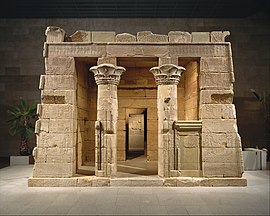| Temple of Dendur | |
|---|---|
 | |
| Completion date | 10 BCE |
| Medium | Aeolian sandstone |
| Subject | Egyptian religion and mythology |
| Dimensions | 4.9 m × 6.4 m × 13 m (16 ft × 21 ft × 43 ft) |
| Location | Metropolitan Museum of Art, New York City, New York, U.S. |
| Accession | 68.154 |
The Temple of Dendur (Dendoor in the 19th century) is a Roman Egyptian religious structure originally located in Tuzis (later Dendur), Nubia about 80 kilometres (50 mi) south of modern Aswan.[1][2] Around 23 BCE, Emperor Augustus commissioned the temple dedicated to the Egyptian goddess Isis and deified brothers Pedesi and Pihor from Nubia.[3][4]
In 1963, as part of the International Campaign to Save the Monuments of Nubia, UNESCO helped rescue and relocate the temple from flooding caused by the Aswan High Dam.[5] Egypt gave the temple to the Metropolitan Museum of Art in New York City, which has exhibited it since 1978.[2]


- ^ Arnold, Dieter (1999). Temples of the Last Pharaohs. Oxford University Press. pp. 244. ISBN 978-0-19-512633-4.
- ^ a b Cite error: The named reference
Bianchi 1978was invoked but never defined (see the help page). - ^ Aldred, Cyril (1978). "The Temple of Dendur". The Metropolitan Museum of Art Bulletin. 36 (1): 6, 15, 30, 46, 48, 50, 57, 61. doi:10.2307/3269059. JSTOR 3269059.
- ^ Cite error: The named reference
metmuseum.org 2021was invoked but never defined (see the help page). - ^ Cite error: The named reference
Patch 2017was invoked but never defined (see the help page).
